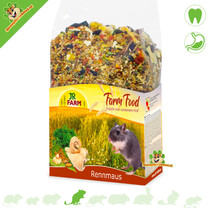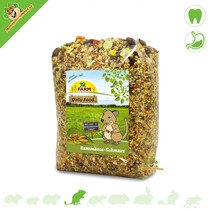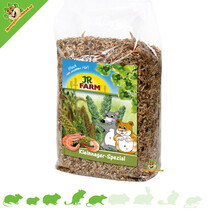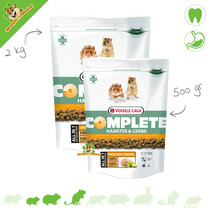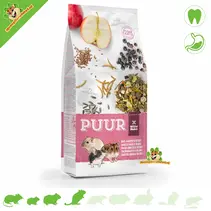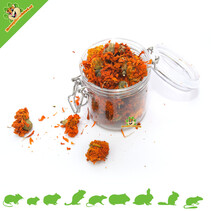Natural food for Gerbils in the Gerbil Webshop!
- Ordered before 5 p.m., shipped the same day!
- Al 14 jaar een begrip!
- Delivery from our own stock
- Ordered before 5 p.m., shipped the same day!
- Al 14 jaar een begrip!
- Delivery from our own stock

Order Gerbil food quickly and easily at DRD Rodent Shop ® The Gerbil Webshop for your Gerbils!
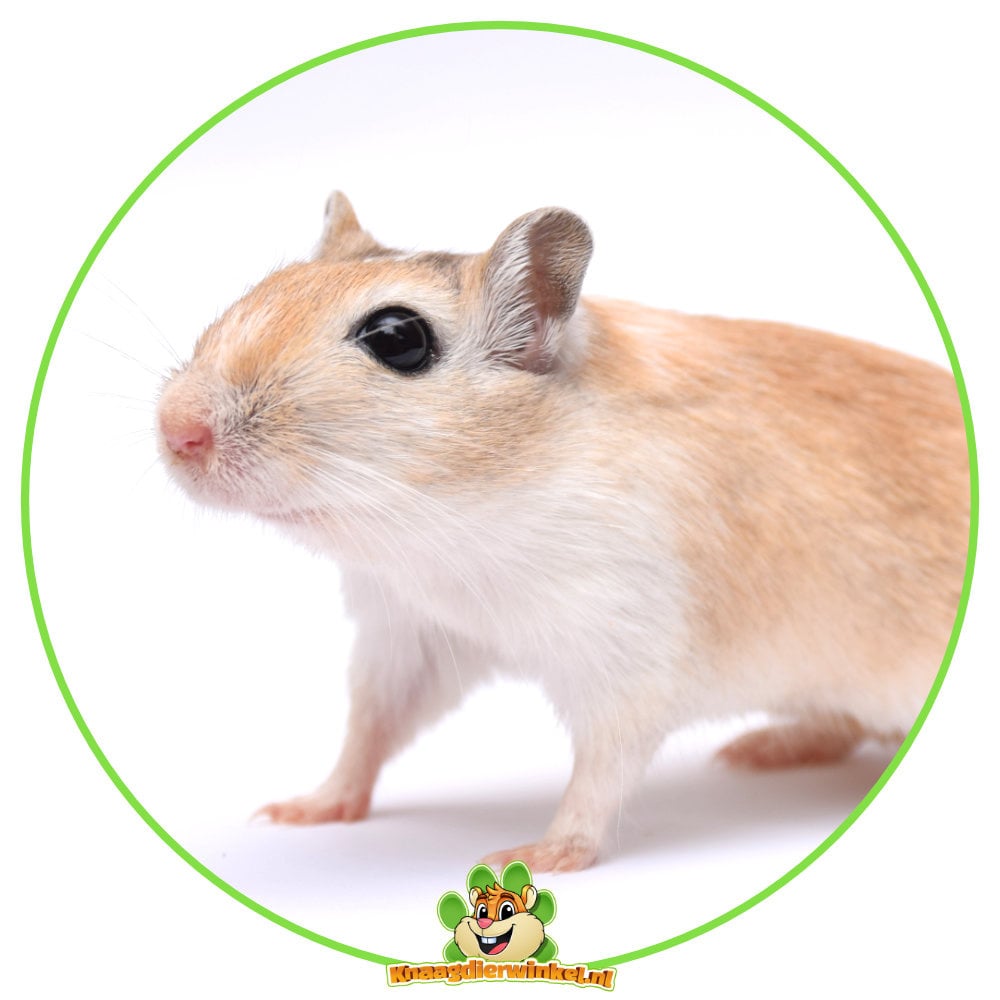 For natural gerbil food for your Gerbils , you are in the right place in our Gerbil webshop ! Do you really want to spoil Gerbils with healthy, balanced gerbil food ? Then look further because with us you will find different types of gerbil food for an attractive price. Ordering is easy and fast at DRD Rodent Shop!
For natural gerbil food for your Gerbils , you are in the right place in our Gerbil webshop ! Do you really want to spoil Gerbils with healthy, balanced gerbil food ? Then look further because with us you will find different types of gerbil food for an attractive price. Ordering is easy and fast at DRD Rodent Shop!
What is good gerbil food?
Gerbils are natural gourmets and have a refined taste when it comes to their food. They love a gastronomic experience in their little world. Imagine them waving their paws in the air and saying, "Bring me the tastiest seeds and grains you can find, my good people!"
But beware, gerbils have their own version of a fast food addiction. They'd happily pull up to the drive-thru and yell, "I'll have an extra large serving of sunflower seeds and a mealworm milkshake, please!" Let's just tell them that a balanced diet is important, even for small rodents.
And let's face it, gerbils have a knack for hidden treasure. They hide their food like little treasure hunters. You might catch them scurrying around under blankets or in their tunnels muttering, "I'll protect my food supply, no one will find these delicious treats!"
So, make sure your gerbils are treated like the foodies they are, but don't forget to help them make healthy choices. And who knows, maybe they'll even get a Michelin star for the best rodent restaurant in town!
What kind of food is suitable for Gerbils?
Gerbils need a balanced diet that is tailored to the nutritional needs of the animals. Because Gerbils are desert animals, they need a meager diet. In the natural habitat of the Gerbil, food and water are difficult to find. A characteristic of the Gerbil is that it drinks little compared to other rodents. They are frugal with food and drink. The body of the Gerbil is not used to too much fat and sugars and therefore these components preferably do not belong in a good gerbil food.
Growing gerbils effectively eat approximately 5 to 6 grams of dry food/day or 8 to 10 g food/100 g BW. Gerbils drink approximately 4 to 10 ml water/100 g BW/day. Total daily water intake (including water in food and metabolic water) is estimated at 8 to 13 percent of body weight.
An optimal protein percentage for growing gerbils seems to be 16%. A magnesium or sodium deficiency can cause baldness and convulsions in gerbils.
 Gerbils eat seeds, grains, plant parts and insects in the wild. Because gerbils naturally occur in dry areas, they are very frugal with water. Gerbils do not drink much and produce little urine. However, they must always have fresh and clean drinking water available. However, you do not have to worry if your gerbils drink little. Gerbils' food should not contain too much fat and sugar. Gerbils need animal proteins. A small amount of green food can be given as a supplement. Gerbils' incisors grow throughout their lives. The incisors wear down by breaking open seeds and gnawing on larger food components. The gerbil has a small blind gut.
Gerbils eat seeds, grains, plant parts and insects in the wild. Because gerbils naturally occur in dry areas, they are very frugal with water. Gerbils do not drink much and produce little urine. However, they must always have fresh and clean drinking water available. However, you do not have to worry if your gerbils drink little. Gerbils' food should not contain too much fat and sugar. Gerbils need animal proteins. A small amount of green food can be given as a supplement. Gerbils' incisors grow throughout their lives. The incisors wear down by breaking open seeds and gnawing on larger food components. The gerbil has a small blind gut.
Protein: Gerbils need animal proteins. The food should contain a protein content of 14-15%. This can be supplemented with, for example, mealworms as a snack. Animal proteins are essential for a good metabolism. The valuable amino acids are important for cell renewal and various metabolic processes.
Fats: Gerbil food should not contain too much fat. A percentage of up to 4% fat in the food is desirable. Gerbils easily become overweight. Therefore, it is important that there is no more than 4% fat in the food.
Fiber: The fiber content in the diet should not exceed 7%. Gerbils need easily digestible energy because they have a fast metabolism. This is mainly obtained from seeds. Many fibers provide too little energy.
Calcium: The calcium: phosphorus ratio should be between 1.1:1 and 1.5-1.
What do Gerbils eat in the wild?
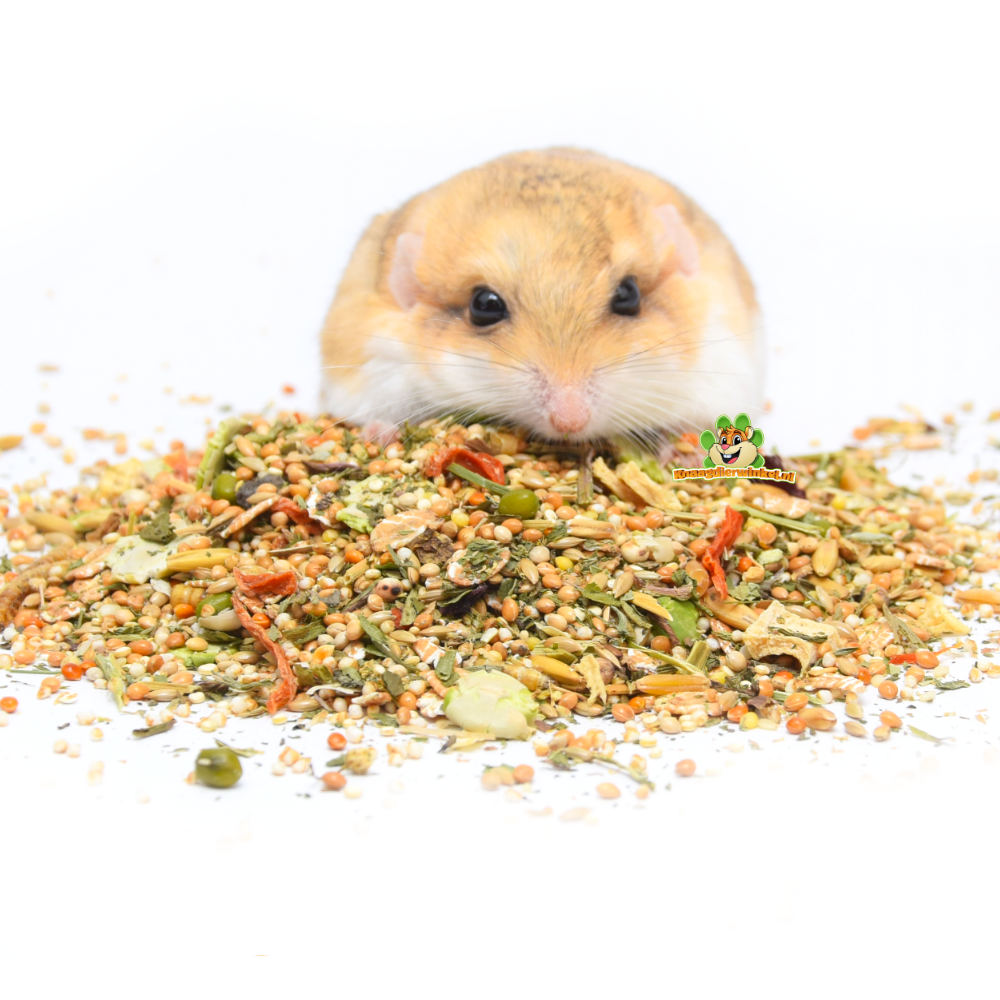 Seeds: Gerbils love seeds and they play an important role in their diet. They can feed on a variety of seeds, such as grass seeds, grains, nuts and seeds of various plants.
Seeds: Gerbils love seeds and they play an important role in their diet. They can feed on a variety of seeds, such as grass seeds, grains, nuts and seeds of various plants.
Grasses and Herbs: Gerbils prefer grasses and herbs that grow abundantly in their natural habitat. They can feed on a variety of grasses and herbs such as meadow grass, dandelions, clover and other available plants.
Leaves and shoots: Gerbils can feed on the leaves and shoots of various plants. They like to nibble on green leaves, young twigs and other delicate plant parts.
Roots and Tubers: Gerbils have the ability to dig for and eat roots and tubers. Root vegetables and other underground parts of plants provide nutrients and moisture to Gerbils in their natural habitat.
Insects: Although Gerbils primarily eat seeds and plant parts, they may occasionally eat insects. This can be done to supplement their diet or if there is a lack of plant food. They may consume small insects such as beetles, grasshoppers and larvae.
How much food should I give my Gerbil per day?
-
This can vary depending on the size, age and health of your gerbil, but on average an adult gerbil will eat between 5-6 grams of dry food per day. Make sure you are offering the right amount to prevent obesity.
Can I give my Gerbil fruits or vegetables?
Gerbils can be fed fruits and vegetables in small quantities, but they should always be fresh and well washed. Be careful not to give watery vegetables such as cucumber, as this can lead to diarrhea. Smaller amounts such as carrots or a piece of apple can be a nice treat.
How does a Gerbil's digestion work?
Ah, the secrets of gerbil digestion! Let's take a look at the culinary world of these little rodents.
The gerbil, a modest granivore, has a digestive system that is perfectly suited to its seed-rich diet. But let’s not forget that they also have a penchant for a little green on their plate. They are like gourmets who feast on herbs, grassy plants, and even the succulent stems of plants. You can almost hear them say, “Ah, a touch of grass, a pinch of herbs, and my meal is complete!”
Now, let’s talk about those famous gerbil incisors. These little cuties grow continuously, which means the gerbil is always looking for food to wear them down. Imagine them as little gnawing masters, performing their own version of “Extreme Makeover: Dental Edition” with their teeth. They’ll gnaw on anything they can find, like they’re their own personal dentist. “Nibble here, nibble there, and my teeth are done!”
And let’s not forget that a gerbil’s stomach is a single chamber. It’s as if they have reserved an intimate table for one in their stomach restaurant. Part of the stomach doesn’t even have a gland, as if it were an exclusive VIP section where only the most refined dishes are served. “Ah, this glandless part is perfect for my seed tasting, and the other glandular part is ideal for some extra digestive enzymes!”
But let's not forget that gerbils also have a small appendix. They're not as fond of coarse fiber as a rabbit is. They like to keep it subtle with less fiber on their menu. They look at coarse fiber and say, "No thanks, we like to keep it smooth."
So there you have it, a gerbil’s digestive system with a touch of humor. It’s a culinary journey of seeds, herbs, tooth wear, and stomach divisions. These little rodents know how to enjoy a good meal. Cheers to gerbil gastronomy!
Oral cavity: This is where the Gerbil plays its own "MasterChef" and thoroughly inspects all food. They chew like true culinary experts and mix the food with their saliva so that the tasty dish is ready to go!
Esophagus: The esophagus is like a slide at an amusement park where food goes on a wild ride to the stomach. The Gerbil prepares for the "esophageal coaster" as the food is swallowed with joy.
Stomach: Welcome to the "Stomach Bistro"! Here, the food is mixed with stomach juices that act as a special sauce to enhance the flavors. The Gerbil hopes that the chef has not added too much hydrochloric acid, otherwise it will be a spicy experience!
Small Intestine: In the "Food Academy" the real party begins! The small intestine is like a culinary laboratory where enzymes and juices are added to completely break down the food. The Gerbil has his own Michelin star chef here who makes sure that every nutrient molecule is perfectly extracted for optimal nutritional absorption.
Colon: Welcome to the "Water Ride"! The colon is like a giant water slide where fluid is absorbed and feces are formed. Gerbil hopes he hasn't drunk too much water before he starts this wild ride, otherwise it will be a splash zone experience!
Rectum: The "Last Stop"! This is where the feces are located, ready to be eliminated from the body. It's like the exit of a movie theater, where the Gerbil quickly runs out to meet the next adventure!
A Gerbil's digestive tract is like a gastronomic adventure where each organ plays its own role in the tasty journey of food. They certainly have a unique digestive system that reflects their fun and adventurous nature!
What do a Gerbil's teeth look like?
A Gerbil's teeth are a fascinating feature of these small rodents. Here are some interesting facts about Gerbil teeth:
Incisors: Gerbils have two large incisors at the front of their mouths, on both the upper and lower jaws. These incisors grow continuously throughout their lives, similar to other rodents. The constant growth is necessary because the Gerbil wears down its teeth while gnawing on different materials, such as food, wood, and toys.
Tooth structure: A gerbil's teeth are covered with a hard layer of enamel, which helps chew and wear down food. Beneath the enamel is dentin, a softer tissue that forms the core of the tooth. Dentin contains tiny tubes that supply the tooth with nutrients.
Rodents with continuously growing teeth: Gerbils belong to the group of rodents with continuously growing teeth, also called "open roots". This means that their teeth do not stop growing, unlike for example humans. By regularly gnawing, a Gerbil's teeth wear down and remain at a healthy length.
Gnawing: Gnawing is essential for Gerbils, not only to wear down their teeth but also to strengthen their jaw muscles. It also helps maintain healthy teeth and satisfies their natural gnawing instinct.
Healthy teeth: To maintain healthy teeth for your Gerbil, it is important to provide him with suitable chewing materials, such as wooden toys and chew sticks. These materials provide resistance and help wear down the teeth. Also, make sure that your Gerbil's diet has a good balance of nutritious foods to promote optimal dental health.
A Gerbil's teeth are an important feature that allows them to process food and gnaw on various materials. Due to their continuously growing teeth and natural gnawing behavior, Gerbils have the necessary resources to maintain healthy teeth.
Does the Fat-tailed Gerbil need different food?
Ah, the Fat-Tailed Gerbil, the culinary adventurer among gerbils! This little rodent has a refined taste that dates back to its insectivorous ancestors. You can almost tell by the way it lifts its pointed snout and says, "I was born to eat insects!"
Now, let’s take a look at regular gerbil food. It’s like a solid meal for the Fat-Tailed Gerbil, a foundation on which he can build. But let’s face it, even the most sophisticated gourmet wants a little variety in his diet every now and then. So in addition to that excellent gerbil food, the Fat-Tailed Gerbil needs a daily dose of insects to satisfy his inner insectivore. “A little mealworm here, a few crickets there, and I’m a happy gerbil!”
Luckily, there are special insect mixes available for these rodent adventurers. It’s like they have their own secret “Bug Mix à la Fat-Tailed Gerbil” with a perfect combination of crawling beetles, hopping crickets and tickling mealworms. They look at it and say, “Ah, the smells, the tastes, the crunchy bits. This is my own personal insect party!”
So there you have it, the Fat-Tailed Gerbil and his insect adventures. From gerbil food to insect dinners, this little rodent knows how to satisfy his culinary cravings. It's as if he's saying, "Give me bugs and I'll be the king of my own rodent kitchen!"
So serve up those insects on a silver platter (or really, just in his food bowl), and watch the Fat-Tailed Gerbil channel his inner insectivore. Enjoy, little adventurer!
Did you know?
Do fat-tailed gerbils naturally eat more insects? Give fat-tailed gerbils extra (dried) insects every now and then.
Where does the Gerbil hide its food?
 Ah, the Gerbil and his strategic food hiding places, a mystery that intrigues us all! When the Gerbil is not busy digging tunnels and building cute little nests, he is busy hiding his precious food supply. But where does he actually hide all that tasty stuff?
Ah, the Gerbil and his strategic food hiding places, a mystery that intrigues us all! When the Gerbil is not busy digging tunnels and building cute little nests, he is busy hiding his precious food supply. But where does he actually hide all that tasty stuff?
Well, this adventurous rodent is not a fan of playing hide-and-seek with his meals. He has a serious business on his hands and that is finding the perfect place to store his food. In the vast steppes, semi-deserts and deserts of Mongolia, Russia and China, where the Mongolian Gerbil has made his home, food sources are scarce. So he has to be smart and secure his food for later use.
If you look closely, you will notice that the Gerbil is a true master at hiding his food. He will use his tiny legs to carry his food down to his underground kingdom of tunnels and chambers. Somewhere deep underground, in his own personal gastronomic cave, he creates a storeroom where his precious seeds and treats are safe from the greedy eyes of others.
But where exactly does he hide his food? Ah, that's the Gerbil's secret! He carefully chooses hidden nooks and crannies, under the guise of "out of sight, out of mind". Maybe he hides his seeds behind a secret door in his tunnels, or maybe he has a hidden treasure chest somewhere in the sand dunes. We'll never really know.
So the next time you see a Gerbil digging and running, remember that he is busy securing his food supply in a place where only he knows the code. It is like he is playing his own version of "Hide the Food" and keeping us all in suspense. It is simply Gerbil magic in action!
So, dear Gerbil, continue your secret mission of hiding food and save those seeds like a true treasure hunter. We admire your skills and your secret storage rooms deep underground. You are the Indiana Jones of the rodent world, and we can't wait to see where your next adventure takes you!
Did you know that about gerbils?
Did you know that Gerbils are real gourmets? They have a refined taste and know exactly what they like. It is as if they are little food critics looking for the perfect taste sensation in their rodent world!
Imagine you are a chef in a Gerbil restaurant. You present them with a delicious salad of juicy seeds, crunchy leaves and fresh herbs. They sniff it, taste it carefully and then give you an approving nod with their cute faces. You know you have found the right recipe that makes their taste buds tingle with joy!
But, just like in a restaurant, Gerbils also have their own favorite foods. Maybe there are some seeds they prefer over others, or they have a preference for certain types of grass. It is important to discover their personal taste preferences and treat them to a menu they love.
And let's not forget that Gerbils also love to discover new flavors. If you surprise them with a little treat every now and then, like a piece of dried fruit or a crunchy mealworm, they will definitely reward you with an energetic and cheerful reaction. It's like they're saying: "Chef, this is great! What a tasty surprise!"
So, remember that Gerbils are not just gnawing on their food, they are also real foodies. Experiment with different flavors and textures to make their eating experience exciting and enjoyable. Who knows, you might become the Michelin star chef of the Gerbil world and get rave reviews from your furry guests!
These plants are allowed for gerbils to eat
| Wild Plants | Branches and Leaves | Vegetables |
|---|---|---|
|
Strawberry leaf |
Currant shrub Apple tree Apricot tree Birch Beech Blueberry bush Blackberry leaf Grape Maple Els It is Oak Forsythia Raspberry bush Hornbeam Hazel Elm Quince tree Gooseberry bush Vulnerable lime tree Mulberry Hawthorn Pear tree Peach tree Poplar Plum tree Plane Ranunculus shrub Fig tree Willow |
Endive Celery Broccoli Zucchini Iceberg lettuce Cucumber Lettuce Bell pepper Parsnip Parsley root Pumpkin Purslane Corn leaf Beetroot Radicchio Romaine lettuce Arugula Spinach Swiss chard Tomato Lamb's lettuce Fennel Chicory Root |









